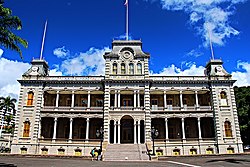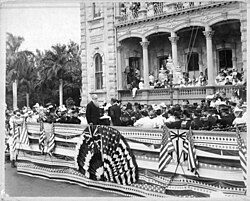ʻIolani Palace
ʻIolani Palace is a building in downtown Honolulu, Hawaii, United States. It was a palace for the kings and queens of Hawaii. It is the only palace in the United States that was used as an official residence by a reigning monarch. Two monarchs governed from ʻIolani Palace. They were King Kalākaua and Queen Liliʻuokalani. After Hawaii stopped having kings and queens in 1893, the building was used as the state's capitol building until 1969.
ʻIolani Palace | |
 | |
ʻIolani Palace is the hallmark of Hawaiian renaissance architecture | |
| Location: | Honolulu, HI |
|---|---|
| Coordinates: | 21°18′24″N 157°51′32″W / 21.30667°N 157.85889°WCoordinates: 21°18′24″N 157°51′32″W / 21.30667°N 157.85889°W |
| Area: | 10.6 acres (4.3 ha) |
| Built: | 1879 |
| Architect: | Thomas J. Baker, Charles J. Wall, Isaac Moore |
| Architectural style: | American Florentine |
| Governing body: | State of Hawaii |
| Part of: | Hawaii Capital Historic District (#78001020) |
| NRHP Reference#: | 66000293[1] |
| Significant dates | |
| Added to NRHP: | October 15, 1966 |
| Designated NHL: | December 29, 1962[2] |
In 1962, ʻIolani Palace became a National Historic Landmark. The palace was restored and opened to the public as a museum in 1978.
History
Royal palace
ʻIolani Palace was built when the king of Hawaii was David Kalākaua. Kalākaua had seen royal palaces in Europe. He had ʻIolani Palace designed to be like those. It was built of brick and concrete. The building was completed in November 1882. It cost over $340,000. It measures about 140 by 100 feet (43 m × 30 m). It is two stories high. It has a basement. It has four corner towers. It has two towers in the center that are 76 feet (23 m) high.
ʻIolani Palace is the only building of its architectural style. The style is called "American Florentine". The palace had electricity and telephones even before the White House had them.
Executive Building
After Hawaii stopped having kings and queens in 1893, the new government of Hawaii took over ʻIolani Palace. The palace was renamed the "Executive Building" for the Republic of Hawaii. Officials made a record of what was in the building. The things that could not be used by the new government were sold at public auctions.
Queen Liliʻuokalani was imprisoned for nine months in a small room on the upper floor after a rebellion in 1895. The quilt she made is still there.
Palace Restoration
In 1930, the inside of ʻIolani Palace was remodeled. The wood framing was replaced by steel and reinforced concrete. In 1935, the name was changed back to ʻIolani Palace.[3]
ʻIolani Palace was made an official National Historic Landmark on December 29, 1962.[2] On October 15, 1966, it was added as site 66000293 to the National Register of Historic Places listings in Oahu.[1] Government offices left the Palace in 1969 and moved to the new Hawaii State Capitol building.
Many things that used to be in the palace have been returned. Money from the government and private donations paid to help make rooms in the palace look like they did during the monarchy era. ʻIolani Palace opened to the public in 1978.[4] In the basement is a photographic display of the Palace, the Hawaiian crown jewels, awards given by the monarchs, and regalia worn by the high chiefs of the islands.
The grounds of ʻIolani Palace are managed by the Hawaii State Department of Land and Natural Resources. The palace building itself is managed as a historical house museum by the Friends of ʻIolani Palace, a non-profit non-governmental organization. The birthdays of King Kalākaua (November 16) and Queen Kapiʻolani (December 28) are celebrated with ceremonies.[5]
ʻIolani Palace Media
U.S. Minister to Hawaiʻi Harold M. Sewall (right) accepts the transfer of Hawaiian state sovereignty from President Sanford Dole, August 12, 1898 on the steps of ʻIolani Palace
References
- ↑ 1.0 1.1 "National Register Information System". National Register of Historic Places. National Park Service. 2007-01-23.
- ↑ 2.0 2.1 "Iolani Palace". National Historic Landmark summary listing. National Park Service. Archived from the original on 2009-08-28. Retrieved 2008-06-21.
- ↑ Ben Levy (December 1985). "Iolani palace nomination form" (PDF). National Register of Historic Places. U.S. National Park Service. Archived from the original (PDF) on 2012-10-08. Retrieved 2010-04-06.
- ↑ "Restoration of the Palace". official web site. Friends of ʻIolani Palace. Archived from the original on 2010-05-03. Retrieved 2010-04-06.
- ↑ Burl Burlingame (April 3, 2008). The only royal residence in the U.S. celebrates the lost Hawaiian monarchy. http://archives.starbulletin.com/2008/04/03/features/story02.html. Retrieved 2010-04-07.
Other websites
| Wikimedia Commons has media related to Lua error in Module:Commons_link at line 62: attempt to index field 'wikibase' (a nil value).. |








